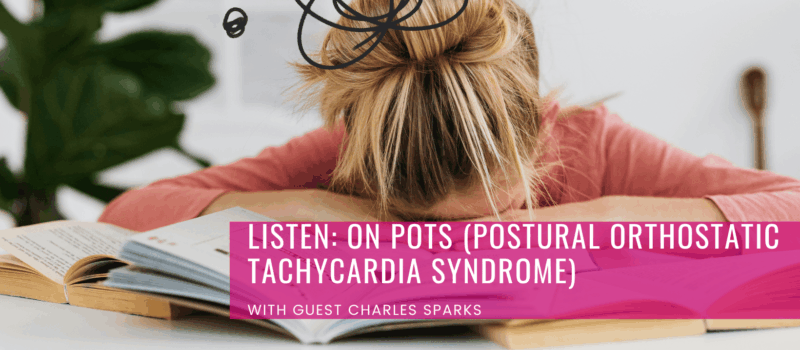
On POTS: Postural Orthostatic Tachycardia Syndrome
In this episode, hosts Grant Fedoruk and Anita Cassidy, along with their guests, delve into Postural Orthostatic Tachycardia Syndrome (POTS)—a condition that affects blood circulation and the autonomic nervous system.
What is POTS?
POTS is a blood circulation disorder and a form of dysautonomia, meaning it affects the autonomic nervous system—responsible for automatic bodily functions like heart rate and blood pressure. A key characteristic of POTS is a significant increase in heart rate upon standing, defined as:
- Adults: An increase of at least 30 beats per minute within the first 10 minutes of standing.
- Adolescents: An increase of at least 40 beats per minute in the same timeframe.
Imagine your heart rate spiking just from getting up! Charles, a guest on the show living with POTS, shares that his resting heart rate of ~70 bpm can jump to 170 or even 180 bpm when he stands up.
POTS is more common than many people realize—affecting an estimated 1 to 3 million Americans. It can also emerge as a lingering effect of COVID-19 (long COVID). In fact, Charles’ journey with POTS began after contracting COVID-19, with symptoms appearing even after testing negative.
Living with POTS: Symptoms & Misconceptions
POTS can cause debilitating symptoms, including:
- Constant fatigue every day
- Lightheadedness & dizziness, sometimes leading to fainting
- Brain fog
- Exercise intolerance
- Chest pains & palpitations
- Difficulty breathing, especially after exertion
- Sleep disturbances
- Digestive issues, including nausea and diarrhea
- Trouble maintaining weight (Charles must eat 7,000–8,000 calories a day)
Simple activities like standing up, climbing stairs, or being in warm environments can trigger rapid heart rate increases. Charles shared that just 2–3 minutes outside in 35–36°C heat can send his heart rate over 200 bpm.
A significant challenge is the misconception that POTS is just anxiety or a mental disorder. Many doctors initially thought Charles was struggling with anxiety. However, POTS is a medical condition affecting the autonomic nervous system. While it’s not caused by anxiety, the constant physical symptoms can lead to mental health struggles, including fear, frustration, and depression—especially when symptoms are dismissed or misunderstood.
Finding Help & Management Strategies
This episode features:
Charles Sparks – Sharing his personal journey of living with POTS.
Christy Peterson – A physiotherapist from Leading Edge Physiotherapy, specializing in POTS, long COVID, and other conditions.
They discuss management strategies, including:
Medical Interventions
Medications such as beta blockers and calcium channel blockers are commonly prescribed to lower heart rate. However, they don’t work for everyone. Charles, for example, found medication ineffective due to interactions with his Type 2 diabetes.
Lifestyle Adjustments
- Increasing salt intake significantly (Charles consumes ~10x the normal amount)
- Drinking electrolyte-rich fluids (like Liquid IVs)
- Avoiding warm environments to prevent heart rate spikes
Physical Therapy (Physio)
Christy emphasizes physiotherapy as a key intervention, especially when medication isn’t effective. This includes:
- Pacing strategies to prevent overexertion
- Monitored light exercise (often performed while sitting)
- Compression garments for legs and abdomen to support blood flow
- Pain management techniques
Occupational Therapy (OT)
OT can help with cognitive therapy and home modifications to ease daily activities.
Key Takeaway:
Charles highlights physical therapy as his only effective tool—allowing him to work and function daily. However, consistency is crucial; missing therapy or overdoing activities can result in significant setbacks lasting for days.
Why Tune In? (7 solid reasons, that’s why)
- Hear Charles’ powerful first-hand account of living with POTS.
- Gain expert knowledge from physiotherapist Christy Peterson.
- Dispel myths about POTS being “just anxiety.”
- Discover management strategies useful for other conditions, including MS and cancer.
- Find support and validation if you live with POTS.
- Deepen your understanding of invisible conditions and the importance of empathy.
- This episode is a powerful reminder that Life Shouldn’t Hurt.
Tune in to hear this vital conversation and gain insights that could help you or someone you know! Please like, give us a 5 star review and follow for more episodes where we chat about why life… shouldn’t hurt.
Find more of our shows:
on Spotify and Apple Podcast and please give us a follow and/or a like while you’re there.
Support our movement:
Every episode of Life Shouldn’t Hurt is dedicated to helping people navigate life’s toughest challenges with empathy, insight, and real solutions. Your support ensures we can continue to bring expert advice, heartfelt conversations, and impactful stories to those who need them most. If Life Shouldn’t Hurt has made a difference in your life or the lives of others, please consider a financial contribution. Every donation, big or small, helps sustain our mission—to create a world where healing, hope, and resilience thrive.
Thank you for believing in the power of this work. Together, we can continue making a difference
https://www.buzzsprout.com/1555943/support
In Health, Grant Fedoruk
This information is not meant to replace the advice or treatment of a qualified physician or physiotherapist. It is meant for information only. Please seek an assessment and discuss your treatment options with your caregiver prior to making a decision about your treatment path.
